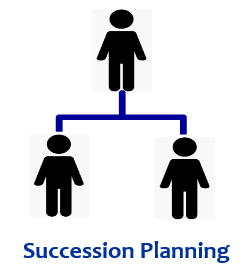Succession Planning
Organizations need to be able to keep moving forward during the inevitable changes that occur from running a business. Employees leave companies at various times for various reasons. Organizations need to make sure they have employees trained and ready to assume the next position in their career path when the time is ready. Succession planning helps ensure that employees are constantly developed and ready and waiting to fill each needed role.
Definition
Succession planning is a systematic process for identifying and developing talented employees who can fill key roles within the organization as they become vacant. This process ensures that the organization will never have a key role open for which another employee is not prepared to step in and take.

About Succession Planning
Succession planning is used to address the inevitable changes that occur when employees leave organizations. People leave organizations for many reasons including retirement, sickness, being fired, or a better position elsewhere. No matter the reason, organizations need to make sure their business is prepared for all contingencies by identifying and developing high-potential employees for advancement into key roles. Succession planning increases the availability of experienced and capable employees that are prepared to assume new roles as they become available.
Essentially, the organization has a continuous process that keeps talent in the pipeline. If a key employee leaves the organization, someone else is waiting in the wings ready to step into his or her role. No time is needed to train and get that new person up and running. Gaps are immediately filled, and the organization seamlessly moves forward.
Unfortunately, many organizations overlooked this process, and they lose significant productivity because of it. If they do not have someone ready to step into the person’s role, it will take time for the new person to learn the role and the responsibilities that come with it.

Succession Planning Process
In order to have a successful succession planning process, the company has to have the right organizational structure in place. The company has to have positions that support collaborative work environments and overlapping responsibilities.
For example, a company may create a Director and an Associated Director position. The Associated Director would be groomed to take over for the director should he or she leave the organization. In the role of Associated Director, he or she would have many of the same responsibilities of the Director and would be able to step in to the Director’s role should the need arise.
After the appropriate structure is in place, the organization should implement the following steps:
- Recruit highly talented individuals.
- Train those individuals so they have the knowledge and skills to perform the tasks required for his or her current role.
- Develop the individual’s knowledge, skills, and abilities so they can perform ever more-challenging roles.
- Prepare them for future roles by giving them additional tasks and responsibilities.
Entire Organization
A succession planning strategy should be implemented at all levels of the organization, and not just at the very top levels. Having succession plans for only top level employees, only ensures the gap will be filled for only a very small percentage of the position openings. However, by having a comprehensive plan for the entire organization, will help ensure all gaps created by movement within the organization gets filled almost immediately.
Often times when a high level position opens, everyone below may shift upward into a new position. Essentially, one employee’s departure can create a ripple effect throughout the organization opening numerous positions. With succession planning throughout the organization, all those gaps would be filled efficiently and effortlessly.
